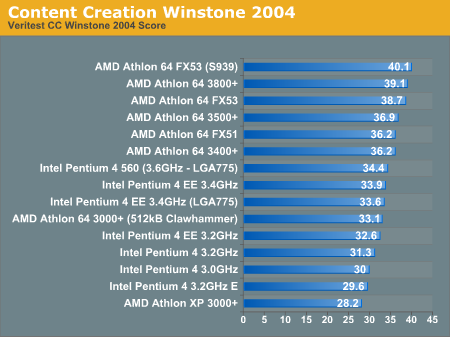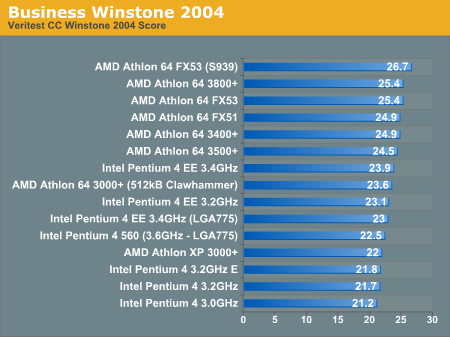Intel's 925X & LGA-775: Are Prescott 3.6 and PCI Express Graphics any Faster?
by Anand Lal Shimpi on June 21, 2004 12:05 PM EST- Posted in
- CPUs
General Application Usage Performance (Winstone)

We have two LGA-775 CPUs in our performance tests, as you can see below: the LGA-775 Pentium 4 3.4GHz Extreme Edition and the new Pentium 4 560 (3.6GHz). Looking at the comparison between the LGA-775 3.4EE and the Socket-478 3.4EE, there is basically no performance difference, which is to be expected.
What's interesting is that the new Pentium 4 560 (3.6GHz) manages to outperform even the Extreme Edition, making it Intel's fastest CPU. Although Intel comes in behind AMD in Content Creation Winstone 2004, these scores are actually based on the original benchmark and not the latest patched version. For whatever reason, the original benchmark disabled multi-threaded rendering in Lightwave, causing Hyper Threading enabled processors to be held back in performance.
Veritest has since addressed the issue and we will be updating our scores to reflect the new patch; until then, this benchmark serves more as a comparison within processor families and not necessarily as an AMD vs. Intel benchmark.

In Business Winstone 2004, we see that the higher clock speed of the Pentium 4 560 (3.6GHz) is not enough to overcome the 2MB L3 cache of the 3.4GHz Extreme Edition. The performance here isn't very spectacular for Intel to begin with; if you're a business user, your choice is clearly AMD.
The Test – Intel's Pentium 4 560 (3.6GHz) vs. the World
General Application Usage Performance (SYSMark)










39 Comments
View All Comments
Pete - Monday, June 21, 2004 - link
*Sweet.I'm thinking those 6800U benches are probably input errors on AT's part, as most other sites show:
1) scores nowhere near that high, especially at that res, &
2) A64s outperforming P4s.
You may be using a very GPU-limited, or at least not-CPU-limited demo, though.
Pete - Monday, June 21, 2004 - link
Swet, fancy Moses! Anand, can you explain the ginormous "vanilla" Far Cry gains by the 6800U? Was IQ the same as the 61.11s (still "point-filtery" in some places compared to ATi) with such prodigious (70%!) gains?justly - Monday, June 21, 2004 - link
AnandI don’t care if that info is strait from Intel or not, it is plain wrong, and I think you are wrong for not questioning this and more so by putting it in print.
Conduction is increased with pressure (be it heat or electrical) but for downward force to affect electrical contact/conduction of a CPU in a socket the pins would have to make contact at their tip. A ZIF socket does not do this, it makes contact on the side of the pins when a sliding plate forces the pin against a contact. If contact was made at the tip of the pins then the CPU would not lay flat against the top of the socket when inserted. This would also prevent aftermarket adapters like this one from powerleap http://www.powerleap.com/PL-iP4.html from being used between the CPU and the socket because it would prevent the pins from contacting.
Once the CPU is inserted into the socket and the lever is locked down the CPU is locked flat against the socket so even if downward pressure was applied it would only help with heat transfer.
Runamile - Monday, June 21, 2004 - link
I agree with #4. The ZIF socket takes care of all contact needed. And as #15 said, there is a sideways force that makes contact with the pins. Ever seen that Tom's Hardware video with the PIII and P4 running w/o a heatsink, albeit very slowly due to freak overheating? They did 'need' the extreame downwards force. Thats all for heat transfer. Period.All in all, very enlightening article. Basicly shows that the entire 925X/LGA-775/Prescott/DDR2/PCI-X release is a mediocre waste of our money. At least for the time being.
paulvds - Monday, June 21, 2004 - link
478 pin electrical contact is by a pinchingsideway force on the pins produced by the ZIF
lever, top down force is totaly irrelevant!
How could you gobble-up that marketing nonsense ?
You advise 'business users' to chose AMD...
Also total nonsense, any entry level value processor will do, they don't need teraMips...
You should go write poetry or novells...
danidentity - Monday, June 21, 2004 - link
Great article Anand...Do you have any info on the supposed Intel-imposed 10% overclocking limit described in Tom's Hardware Guide's LGA775 article here?
http://www.tomshardware.com/motherboard/20040619/s...
retrospooty - Monday, June 21, 2004 - link
Nice article...It just basically proves what we have all suspected all along. DDR2, PCI express, and socket 775 dont offer any compelling reason to upgrade (for now anyhow).
Of course in the future (maybe 2005 if we're lucky), when graphics cards can utilize the extra bandwidth of PCI express it will be faster than AGP 8x.
Of course in the future (maybe 2005 if we're lucky), when DDR2 800 mhz is standard, it will be faster than low latency DDR400
Of course in the future (even if hell freezes over) the message is clear socket 775 has failed :D
LOL !
T8000 - Monday, June 21, 2004 - link
I think the pins in the LGA775 socket are a lot longer then the CPU needs.So adding some kind of non conductive shim around the pins could make this socket a lot more reliable.
It could be as simple as a thin plastic plate with 775 holes in it, that could be inserted before the CPU, leaving just enough pin length to mount the CPU, without the risk of bending those pins.
Anand Lal Shimpi - Monday, June 21, 2004 - link
phobsThanks for the heads up, we added the last two pages of benchmarks after the fact and I forgot to remove that line :)
Take care,
Anand
Anand Lal Shimpi - Monday, June 21, 2004 - link
justlyThat information is straight from Intel - the force of the heatsink was used to maximize heat transfer, but not that much force is necessary to maximize heat transfer. The rest of the force is needed to ensure that there is good contact between the pins and their contacts.
Take care,
Anand